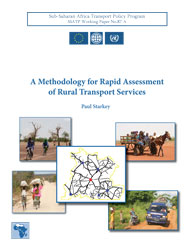The
Rapid Assessment of Rural Transport Services
a methodology for the rapid acquisition of the key understanding
required for informed transport planning
 Summary
Summary
Background to study
Rural transport services are often inadequate. Passenger and goods transport needs improving to stimulate rural economies and reduce poverty. Understanding existing rural transport systems and constraining factors is a precondition for appropriate policy action.
The Sub-Saharan Africa Transport Policy Program (SSATP) commissioned a study to develop and test a methodology for the rapid assessment of rural transport systems. The guidelines specified passenger and freight transport for distances of 5-200 km, encompassing much rural transport, but excluding within-village transport, long-distance national transport and international corridors. In 2005, a multidisciplinary team met in Ethiopia to devise the survey methodology. Four national experts and the team leader implemented the methodology in parts of Burkina Faso, Cameroon, Tanzania and Zambia. The team reconvened in Kenya to review the methodological lessons and survey findings.
The methodology developed
Rural transport systems operate on hub and spoke systems at several levels. Key rural hubs are provincial/regional towns, market/district towns and villages. Spokes have catchment populations using them to access markets or services. The various spokes and hubs have characteristic combinations of transport, including trucks, buses, minibuses, pickups and intermediate means of transport (IMTs). The smallest spokes are footpaths while national spokes form transport corridors. The methodology surveys transport types, operators, users and regulators at sampled hubs and spokes, stratified by hub hierarchy and remoteness. This provides a rapid overview of rural transport systems, highlighting key constraints, stakeholder views and proposals for improvements.
A region, representing about 5 percent of the country, is chosen where the transport catchment area corresponds approximately to administrative boundaries. Within this area, open-ended interviews are held with the regulatory authorities (local government, police) at provincial, district and village levels. Operators, suppliers and repairers of transport devices (motorized and non motorized) are interviewed and operating costs and fares recorded. Interviews are conducted with users (and potential users) of transport including farmers, traders, employees, household managers, school authorities, pupils, health service providers, patients and marginalized people. Five interviews (at least two with women) are needed per stakeholder category and are stratified for isolation. Traffic counts (including pedestrians and IMTs) are carried out on selected provincial, market and village spokes on market and non-market days. All data acquired is geo-referenced by taking global positioning system (GPS) coordinates.
During the survey, observations, data and stakeholder opinions are reviewed on a daily basis. Information is specifically triangulated by comparing information from different sources and anomalies are investigated immediately. Survey guidelines stress the importance of poverty focus and crosscutting gender, safety and HIV/AIDS issues. Complementary national level document reviews and interviews ascertain the positions of key institutional stakeholders, the policy and regulatory frameworks, and the availability of relevant data.
Implementation, reporting and follow-up
The participative methodology requires two months to implement (including planning and reporting). One transport professional, or a small team of experts, undertakes all the semi-structured (rapid rural appraisal) interviews. Enumerators are not employed for interviews. Undertaking the study will provide excellent experience for transport professionals.
This document contains practical advice relating to local observations, interview techniques, survey opportunities and traffic counts. Illustrative data forms and check lists of possible topics are provided, for modification according to local needs.
The information collected should lead to estimates of the regional fleet of motorized and non-motorized vehicles, and the traffic characteristics of the sampled spokes. Tables of passenger and freight costs for different transport means and road types can be compiled. Many results can be presented in graphical form, including public transport routes and areas without access to motorized transport. Computer-generated maps can be used as models in subsequent planning. The survey processes will generate valuable information and also stimulate debate on improving rural transport services. This momentum should be followed up with stakeholder workshops in the surveyed area and a national workshop on improving rural transport services.
The survey methodology was tested in four countries and five detailed reports are available to consult. The findings of these surveys have been summarized in the companion SSATP working paper: Rural transport services in Africa: lessons from surveys in Burkina Faso, Cameroon, Tanzania and Zambia. This also contains a discussion of the key issues that emerged, and the implications for improving rural transport services.
Download
report (pdf file 1.8
Mbyte):
The rapid assessment of rural transport services: a methodology for the rapid acquisition of the key understanding required for informed transport
planning. SSATP Working Paper 87A. Starkey, P, 2007. Click for full report
(pdf file 1.8 Mbyte)
Download summary only (pdf file
260kb),
See and/or download related reports:
 Lessons Lessonsfrom All Countries Surveyed Full document 3.4Mb |
 Boucle
du
Mouhoun Boucle
du
MouhounBurkina Faso Summary (pdf) 100kb Full document 1.0Mb |
 Southern SouthernRegion Cameroon Summary (pdf) 160kb Full document 1.8Mb |
 Iringa IringaRegion Tanzania Summary (pdf) 121kb Full document 1.1Mb |
 Singida Region Tanzania Full document 1.5Mb |
 Luapula Province Zambia Full document 1.2Mb |
Below are some other publications relating to Rural Transport Services which may be relevant


Starkey P, 2002. Moyens de transport locaux pour le développement rural. Department for International Development (DFID), London, UK. 48p. ISBN 1 86192 428 3. (Screen resolution)
9 Mb
8 Mb


1.5 Mb
860kb



1.9Mb
550 kb